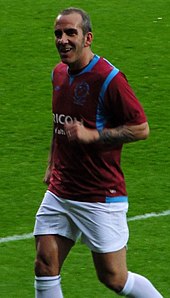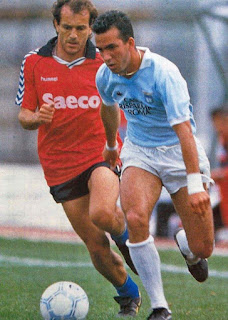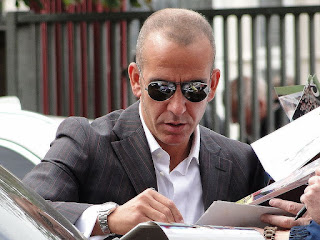NEW - Paolo Di Canio - footballer
Sublime talent overshadowed by fiery temperament
The brilliant but controversial footballer Paolo Di Canio was born on this day in 1968 in the Quarticciolo neighbourhood of Rome. Di Canio, an attacking player with a reputation for scoring spectacular goals, played for several of Italy’s top clubs but also forged a career in Britain, joining Glasgow Celtic in Scotland and representing Sheffield Wednesday, West Ham United and Charlton Athletic during a seven-year stay in England. After finishing his playing career back in Italy, he returned to England to become manager of Swindon Town and then Sunderland, although it was a brief stay. Di Canio scored almost 150 goals in his career but his fiery temper landed him in trouble on the field while his political views - he was openly a supporter of fascism - attracted negative headlines off it. Despite growing up in a working-class area of Rome which was a stronghold of AS Roma fans, Di Canio supported their city rivals SS Lazio from an early age. As a child, he was overweight, but his love for football drove him to beat his addiction to junk food and high-calorie fizzy drinks and become supremely physically fit. Read more…
____________________________________
Ottorino Respighi – violinist and composer
Talented Bolognese brought a Russian flavour to Italian music
The musician Ottorino Respighi was born on this day in 1879 in an apartment inside Palazzo Fantuzzi in the centre of Bologna. As a composer, Respighi is remembered for bringing Russian orchestral colour and some of Richard Strauss’s harmonic techniques into Italian music. He is perhaps best known for his three orchestral tone poems Fountains of Rome, Pines of Rome and Roman Festivals, but he also wrote several operas. Respighi was born into a musical family and learnt to play the piano and violin at an early age. He studied the violin and viola with Federico Sarti at the Liceo Musicale in Bologna and then went to St Petersburg to be the principal violinist in the orchestra of the Imperial Theatre. While he was there he studied with Nicolai Rimsky-Korsakov and acquired an interest in orchestral composition. One of Respighi’s piano concertos was performed at Bologna in 1902 and an orchestral piece by him was played at the Metropolitan Opera House in New York the same year. His operas brought him more recognition and in 1913 he was appointed as professor of composition at the prestigious St Cecilia Academy in Rome. Read more…
____________________________________
Gianluca Vialli - footballer and coach
Striker who managed Chelsea has faced personal battle
The footballer Gianluca Vialli, who enjoyed success as a player in Italy and England and led Chelsea to five trophies as manager of the London club, was born on this day in 1964 in Cremona in Lombardy. After beginning his professional career with his local team, Cremonese, Vialli spent eight seasons with Sampdoria of Genoa, helping a team that had seldom previously finished higher than mid-table in Serie A enjoy their most successful era, winning the Coppa Italia three times, the European Cup-Winners’ Cup and an historic first Serie A title in 1990-91. He then spent four years with Juventus, winning another Scudetto in 1994-95 and becoming a Champions League winner the following season. He signed for Chelsea in 1996 as one of the first in a wave of top Italian players arriving in the Premier League in the second half of that decade, becoming player-manager in 1998 after the man who signed him, Ruud Gullit, was sacked. In the blue of Chelsea, Vialli won medals in the FA Cup as a player, the Football League Cup, the Cup-Winners’ Cup and the UEFA Super Cup as player-manager. Read more…
____________________________________
Adriano Panatta – tennis player
French Open champion was most at home on the clay
The only tennis player ever to defeat Bjorn Borg at Roland Garros in Paris, Adriano Panatta was born on this day in 1950 in Rome. A successful singles player, Panatta reached the peak of his career in 1976 when he won the French Open, gaining his only Grand Slam title, defeating the American player, Harold Solomon, in the final 6-1, 6-4, 4-6, 7-6. Panatta learnt to play tennis as a youngster on the clay courts of the Tennis Club Parioli in Rome, where his father was the caretaker. He won top-level titles at Bournemouth in 1973, Florence in 1974 and at Kitzbuhel in Austria and Stockholm in 1975. In the same year that he won the French Open, Panatta won the Italian Open in Rome, beating Guillermo Vilas in the final 2-6, 7-6, 6-2, 7-6. In the first round of the competition he had saved 11 match points in his match against the Australian Kim Warwick. Panatta ended 1976 by helping Italy capture its only Davis Cup title, winning two singles and a doubles rubber in the final against Chile. He also reached his career-high singles ranking of World number four that year. The only player to have defeated Bjorn Borg in the French Open, Panatta had the distinction of achieving this feat twice. Read more…
_____________________________________
Manlio Brosio - NATO secretary-general
Anti-Fascist politician became skilled diplomat
Manlio Brosio, the only Italian to be made a permanent secretary-general of the North Atlantic Treaty Organisation (NATO), was born on this day in 1897 in Turin. Brosio, whose distinguished diplomatic career had seen him hold the office of Italian ambassador to the Soviet Union, Britain, the United States and France, was appointed to lead NATO in 1964 and remained in post until 1971, the second longest-serving of the 13 secretary-generals so far. Known for his congenial personality, he insisted that others behaved courteously and with respect for etiquette, while conducting himself with self-restraint. This enabled him to maintain a good relationship with all NATO ambassadors and helped him manage a number of difficult situations. Some critics felt he was too cautious but his low-key approach is now credited with keeping NATO together during the crisis that developed in 1966 when General Charles de Gaulle, the French president, threatened the organisation's existence by insisting that NATO removed all its military installations from France within a year. France was one of three nuclear powers among the 15 members of NATO. Read more…
.jpg)

.jpg)

.jpg)







.jpg)

%20(2).jpg)
.jpg)
.jpg)
